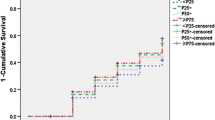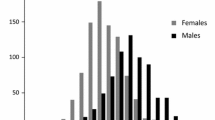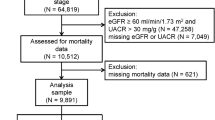Abstract
Evidence is limited on the association between hyperuricaemia and mortality in children and adolescents. This study was to investigate this association in the paediatric population. The study included children and adolescents who had undergone serum uric acid (SUA) measurement at the Chang Gung Memorial Hospital between 1997 and 2008. The survival status and cause of death of the included were ascertained by examining the National Death Registry of Taiwan. Hyperuricaemia was defined as a SUA level greater than 7.0 mg/dL. We included 13,241 patients (male, n = 7,454; female, n = 5,787) of mean age 14.3 ± 4.9 years. During the 82,800 person-years of follow-up, 455 deaths were identified, which corresponded to a crude mortality rate of 5.50 deaths per 1,000 person-years. Compared with individuals with a SUA <6.0 mg/dL, those with a SUA of 6.0–8.9, 9.0–11.9 and ≥12 mg/dL had an age- and sex-adjusted HR (95 % CI) of 1.02 (0.82–1.26), 1.48 (1.08–2.02) and 4.73 (2.67–8.37). After adjustment for age, sex and history of diabetes mellitus and hypertension, hyperuricaemia was found to be associated with a HR (95 % CI) of 1.38 (1.13–1.69; p < 0.001) for all-cause mortality. Hyperuricaemia was associated with an increased risk of mortality due to cardiovascular diseases (HR, 5.0; 95 % CI 1.79–13.94; p = 0.001) and kidney diseases (11.71; 3.13–43.78; p < 0.001). Paediatric patients with hyperuricaemia were at increased risk of mortality, especially due to kidney and cardiovascular diseases.

Similar content being viewed by others
References
Fang J, Alderman MH (2000) Serum uric acid and cardiovascular mortality the NHANES I epidemiologic follow-up study, 1971–1992. National Health and Nutrition Examination Survey. JAMA 283(18):2404–2410. doi:10.1001/jama.283.18.2404
Alper AB Jr, Chen W, Yau L, Srinivasan SR, Berenson GS, Hamm LL (2005) Childhood uric acid predicts adult blood pressure: the Bogalusa Heart Study. Hypertension 45(1):34–38. doi:10.1161/01.HYP.0000150783.79172.bb
Feig DI, Johnson RJ (2003) Hyperuricemia in childhood primary hypertension. Hypertension 42(3):247–252. doi:10.1161/01.HYP.0000085858.66548.59
Ford ES, Li C, Cook S, Choi HK (2007) Serum concentrations of uric acid and the metabolic syndrome among US children and adolescents. Circulation 115(19):2526–2532. doi:10.1161/CIRCULATIONAHA.106.657627
Syrjanen J, Mustonen J, Pasternack A (2000) Hypertriglyceridaemia and hyperuricaemia are risk factors for progression of IgA nephropathy. Nephrol Dial Transplant 15(1):34–42. doi:10.1093/ndt/15.1.34
Van Albada ME, Loot FG, Fokkema R, Roofthooft MT, Berger RM (2008) Biological serum markers in the management of pediatric pulmonary arterial hypertension. Pediatr Res 63(3):321–327. doi:10.1203/PDR.0b013e318163a2e7
Kedar A, Grow W, Neiberger RE (1995) Clinical versus laboratory tumor lysis syndrome in children with acute leukemia. Pediatr Hematol Oncol 12(2):129–134. doi:10.3109/08880019509029545
Baker JF, Krishnan E, Chen L, Schumacher HR (2005) Serum uric acid and cardiovascular disease: recent developments, and where do they leave us? Am J Med 118(8):816–826. doi:10.1016/j.amjmed.2005.03.043
Loeb JN (1972) The influence of temperature on the solubility of monosodium urate. Arthritis Rheum 15(2):189–192. doi:10.1002/art.1780150209
Lu TH, Shau WY, Shih TP, Lee MC, Chou MC, Lin CK (2001) Factors associated with errors in death certificate completion. A national study in Taiwan. J Clin Epidemiol 54(3):232–238. doi:10.1016/S0895-4356(00)00299-7
Brodov Y, Behar S, Boyko V, Chouraqui P (2010) Effect of the metabolic syndrome and hyperuricemia on outcome in patients with coronary artery disease (from the Bezafibrate Infarction Prevention Study). Am J Cardiol 106(12):1717–1720. doi:10.1016/j.amjcard.2010.07.046
Panero F, Gruden G, Perotto M et al (2012) Uric acid is not an independent predictor of cardiovascular mortality in type 2 diabetes: a population-based study. Atherosclerosis 221(1):183–188. doi:10.1016/j.atherosclerosis.2011.11.042
Jones DP, Richey PA, Alpert BS, Li R (2008) Serum uric acid and ambulatory blood pressure in children with primary hypertension. Pediatr Res 64(5):556–561. doi:10.1203/PDR.0b013e318183fd7c
Baldree LA, Stapleton FB (1990) Uric acid metabolism in children. Pediatr Clin North Am 37(2):391–418
Chang HY, Pan WH, Yeh WT, Tsai KS (2001) Hyperuricemia and gout in Taiwan: results from the Nutritional and Health Survey in Taiwan (1993–96). J Rheumatol 28(7):1640–1646
Lee MS, Wahlqvist ML, Yu HL, Pan WH (2007) Hyperuricemia and metabolic syndrome in Taiwanese children. Asia Pac J Clin Nutr 16(Suppl 2):594–600
Darmawan J, Valkenburg HA, Muirden KD, Wigley RD (1992) The epidemiology of gout and hyperuricemia in a rural population of Java. J Rheumatol 19(10):1595–1599
Chang FT, Chang SJ, Wu YY, Wang TN, Ko YC (1995) Body mass index and hyperuricemia differences between aboriginal and non-aboriginal children in Taiwan. Gaoxiong Yi Xue Ke Xue Za Zhi 11(6):315–321
Nicholls A, Snaith ML, Scott JT (1973) Effect of oestrogen therapy on plasma and urinary levels of uric acid. BMJ 1(5851):449–451
Adamopoulos D, Vlassopoulos C, Seitanides B, Contoyiannis P, Vassilopoulos P (1977) The relationship of sex steroids to uric acid levels in plasma and urine. Acta Endocrinol (Copenh) 85(1):198–208. doi:10.1530/acta.0.0850198
Garbagnati E (1996) Urate changes in lean and obese boys during pubertal development. Metabolism 45(2):203–205. doi:10.1016/S0026-0495(96)90054-2
Khosla UM, Zharikov S, Finch JL et al (2005) Hyperuricemia induces endothelial dysfunction. Kidney Int 67(5):1739–1742. doi:10.1111/j.1523-1755.2005.00273.x
Johnson RJ, Kang DH, Feig D et al (2003) Is there a pathogenetic role for uric acid in hypertension and cardiovascular and renal disease? Hypertension 41(6):1183–1190. doi:10.1161/01.HYP.0000069700.62727.C5
Zhou X, Matavelli L, Frohlich ED (2006) Uric acid: its relationship to renal hemodynamics and the renal renin-angiotensin system. Curr Hypertens Rep 8(2):120–124. doi:10.1007/s11906-006-0007-x
Kuo CF, Yu KH, Luo SF et al (2010) Role of uric acid in the link between arterial stiffness and cardiac hypertrophy: a cross-sectional study. Rheumatology 49(6):1189–1196. doi:10.1093/rheumatology/keq095
Acknowledgments
The authors would like to thank the Ministry of Education of Taiwan and Chang Gung Memorial Hospital for their financial support of this research, and the Graduate Institute of Clinical Medical Sciences, Chang Gung University, for methodological assistance. This study is based on data from the National Death Registry, provided by the Bureau of Health Promotion, Department of Health, Taiwan. The conclusions herein do not represent the opinions of the Bureau.
Conflict of interest
The authors have no conflict of interest to declare.
Author information
Authors and Affiliations
Corresponding author
Rights and permissions
About this article
Cite this article
Hsia, SH., Chou, IJ., Kuo, CF. et al. Survival impact of serum uric acid levels in children and adolescents. Rheumatol Int 33, 2797–2802 (2013). https://doi.org/10.1007/s00296-013-2808-y
Received:
Accepted:
Published:
Issue Date:
DOI: https://doi.org/10.1007/s00296-013-2808-y




